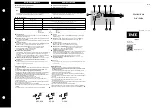
G-2
Distributed Network Protocol (DNP) 3.00
Date Code 20020129
SEL-387E Instruction Manual
Label
Description
Default
REPADR
DNP Address to report to (0–65534) 0
NUMEVE
Number of events to transmit on (1–200) 10
AGEEVE
Age of oldest event to transmit on (0–60 sec.)
2.0
The RTS signal may be used to control an external transceiver. The CTS signal is used as a
DCD input, indicating when the medium is in use. Transmissions are only initiated if DCD is
deasserted. When DCD drops, the next pending outgoing message may be sent once an idle time
is satisfied. This idle time is randomly selected between the minimum and maximum allowed
idle times (i.e., MAXDLY and MINDLY). In addition, the SEL-387E monitors received data
and treats receipt of data as a DCD indication. This allows RTS to be looped back to CTS in
cases where the external transceiver does not support DCD. When the SEL-387E transmits a
DNP message, it delays transmitting after asserting RTS by at least the time in the PREDLY
setting. After transmitting the last byte of the message, the SEL-387E delays for at least
PSTDLY milliseconds before deasserting RTS. If the PSTDLY time delay is in progress (RTS
still high) following a transmission and another transmission is initiated, the SEL-387E transmits
the message without completing the PSTDLY delay and without any preceding PREDLY delay.
The RTS/CTS handshaking may be completely disabled by setting PREDLY to OFF. In this
case RTS is forced high and CTS is ignored, with only received characters acting as a DCD
indication. The timing is the same as above, but PREDLY functions as if it were set to 0, and
RTS is not actually deasserted after the PSTDLY time delay expires.
D
ATA
-L
INK
O
PERATION
It is necessary to make two important decisions about the data-link layer operation. One is how
to handle data-link confirmation, the other is how to handle data-link access. If a highly reliable
communications link exists, the data-link access can be disabled altogether, which significantly
reduces communications overhead. Otherwise, it is necessary to enable confirmation and
determine how many retries to allow and what the data-link time-out should be. The noisier the
communications channel, the more likely a message will be corrupted. Thus, the number of
retries should be set higher on noisy channels. Set the data-link time-out long enough to allow
for the worst-case response of the master plus transmission time. When the SEL-387E decides
to transmit on the DNP link, it has to wait if the physical connection is in use. The SEL-387E
monitors physical connections by using CTS input (treated as a Data Carrier Detect) and
monitoring character receipt. Once the physical link goes idle, as indicated by CTS being
deasserted and no characters being received, the SEL-387E will wait a configurable amount of
time before beginning a transmission. This hold-off time will be a random value between the
MINDLY and MAXDLY setting values. The hold-off time is random, which prevents multiple
devices waiting to communicate on the network from continually colliding.
D
ATA
A
CCESS
M
ETHOD
Based on the capabilities of the system, it is necessary to choose a method for retrieving data on
the DNP connection. The following table summarizes the main options, listed from least to most
efficient, and indicates corresponding key related settings.
Содержание SEL-387E
Страница 8: ......
Страница 10: ......
Страница 12: ......
Страница 50: ......
Страница 124: ......
Страница 176: ......
Страница 196: ......
Страница 198: ......
Страница 242: ......
Страница 270: ......
Страница 308: ......
Страница 422: ......
Страница 428: ......
Страница 432: ......
Страница 448: ......
Страница 450: ......
Страница 462: ......
















































